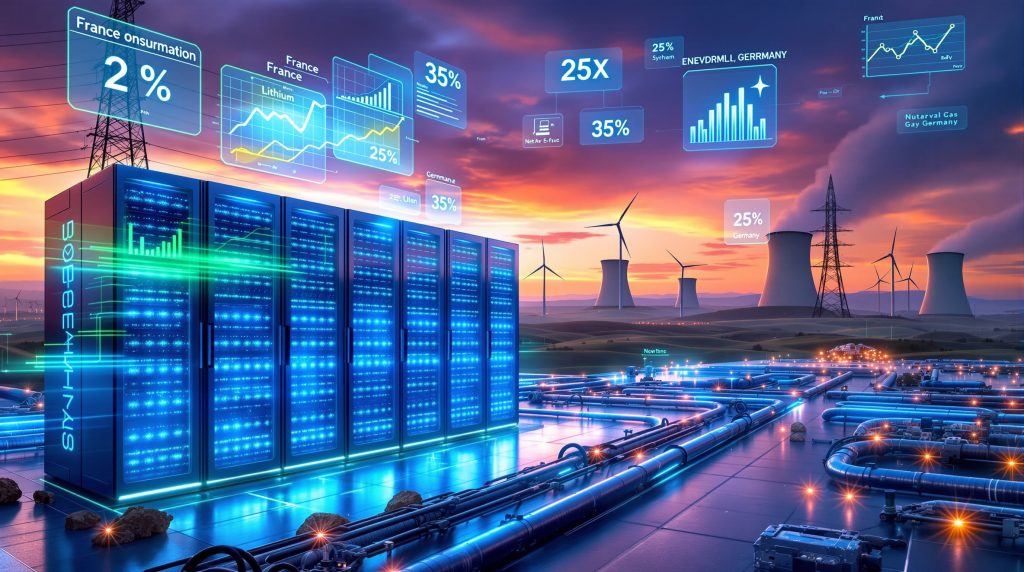Understanding the Scale of AI's Energy Appetite
AI energy demand represents one of the most significant technological disruptions to global energy markets in decades, with data centres now consuming electricity equivalent to entire nations. Current global AI infrastructure accounts for approximately 2% of total electricity demand worldwide, but this figure represents only the beginning of a massive transformation.
Industry projections suggest this consumption could reach 3% by 2040, though some analysts warn the actual growth may be far more dramatic. The scale becomes clearer when considering that major tech companies are committing $350 billion in capital expenditure this year alone, with even larger investments planned for subsequent years.
This energy appetite extends beyond simple computation. Modern AI systems require vast memory-intensive operations that consume significantly more power than traditional computing tasks. The cooling infrastructure alone can account for 20-40% of total data centre power consumption, representing a substantial additional burden on electrical grids.
The Trillion-Dollar Infrastructure Challenge
Training advanced AI models requires thousands of specialised processors operating continuously for weeks or months. Unlike traditional computing applications, AI workloads maintain consistently high power draw throughout their operational cycles, creating sustained demand that challenges existing infrastructure capacity.
The energy requirements extend across multiple components:
• Processing units: GPUs and specialised tensor processing units consuming 300-700 watts each
• Memory systems: High-bandwidth memory requiring constant power for data retention
• Cooling infrastructure: Advanced liquid cooling systems replacing traditional air conditioning
• Power conversion: Multiple voltage transformations creating efficiency losses
• Storage systems: High-speed storage arrays maintaining constant availability
Each AI interaction requires substantially more computational resources than traditional web searches, though exact multipliers vary significantly depending on model complexity and query type. This fundamental difference in resource requirements creates entirely new categories of infrastructure demand.
Why AI Systems Demand Massive Power Resources
Modern AI operations necessitate continuous processing capabilities that dwarf conventional computing requirements. Furthermore, the AI energy demand continues expanding as model complexity increases and deployment scales across various industries.
The computational intensity stems from parallel processing requirements where thousands of calculations occur simultaneously. Training large language models often involves processing trillions of parameters, each requiring multiple mathematical operations and memory access cycles.
In addition, inference operations – where trained models respond to user queries – maintain substantial power requirements despite being less intensive than training processes. The cumulative effect of billions of daily interactions creates sustained electrical demand patterns.
How Will Energy Markets Transform Under AI Pressure?
Natural Gas Sector Positioning for Growth
Natural gas markets face unprecedented demand pressures as AI infrastructure expands across the United States. According to research from Porter and Company, AI data centres will drive US natural gas demand from essentially zero to 6 billion cubic feet daily by 2030. This projection represents a massive shift in consumption patterns that could fundamentally alter domestic energy allocation.
The timing creates significant tension between domestic AI infrastructure needs and international export commitments. The United States has positioned itself as a major liquefied natural gas exporter, particularly as European nations seek alternatives to Russian energy supplies. However, the domestic demand surge from AI operations may force difficult policy decisions about resource allocation.
Current baseline consumption provides context for this growth. The US natural gas forecast indicates total national consumption of approximately 31-32 trillion cubic feet annually, or roughly 8.8 billion cubic feet daily. The projected AI-driven increase of 6 billion cubic feet represents a substantial portion of total demand.
Regional variations in natural gas availability and pricing will likely influence data centre location decisions. States with abundant natural gas reserves and existing pipeline infrastructure may gain competitive advantages in attracting AI investments, while regions dependent on energy imports could face higher operational costs.
Nuclear Renaissance Driven by Baseload Requirements
Nuclear energy has emerged as a critical component of AI infrastructure strategy due to its ability to provide consistent baseload power. In late October 2025, the US government announced formation of a strategic partnership with Cameco Corporation and Brookfield Asset Management to accelerate nuclear reactor deployment with at least $80 billion in investment.
This announcement reflects recognition that AI energy demand requires uninterrupted power supply that renewable sources alone cannot guarantee. Nuclear plants provide the consistent, high-capacity electricity generation necessary for large-scale data centre operations without the intermittency challenges associated with wind and solar power.
The uranium supply chain faces significant constraints after a decade-long industry contraction. Following the 2011 Fukushima disaster, uranium spot prices declined from $66 per pound in 2007 to approximately $20 per pound by 2016, according to US Geological Survey data. Many uranium companies faced severe financial distress during this period, leading to mine closures and reduced exploration activities.
Key challenges facing nuclear expansion include:
• Development timelines: 10-15 years from planning to operation for new reactors
• Regulatory approval: 3-5 years for licensing and permitting processes
• Capital requirements: Billions of dollars per reactor construction
• Skilled workforce: Limited availability of nuclear-qualified personnel
• Uranium supply: Mining capacity insufficient for projected demand growth
The Cameco partnership represents an attempt to address these bottlenecks through strategic coordination between government policy and private sector capabilities. However, the long development timelines mean immediate supply-demand imbalances are likely to persist. Consequently, investors are monitoring the latest uranium mining update for market implications.
Renewable Energy Storage Revolution
Battery energy storage systems have become the dominant narrative in renewable energy markets, shifting focus away from electric vehicle applications toward grid-scale power management. Tesla reported record quarterly energy storage deployments in Q3 2024, reflecting broader industry momentum in this sector.
The lithium market has responded to this demand shift, with prices recovering approximately 20% over recent quarters after experiencing significant declines in 2022-2023. This recovery reflects recognition that grid-scale storage represents a substantial new demand category for lithium-ion battery technology.
China's aggressive investment in battery energy storage systems creates additional market dynamics. Chinese manufacturers have achieved significant cost reductions in lithium iron phosphate battery technologies, making grid-scale deployments increasingly economical compared to traditional power grid infrastructure upgrades.
Storage system specifications vary by application:
• Duration requirements: 4-hour systems for peak shaving versus 6+ hour systems for load shifting
• Round-trip efficiency: 85-95% for lithium-ion technologies
• Cycle life: 6,000-10,000 cycles depending on chemistry and operating conditions
• Temperature management: Advanced thermal control systems for optimal performance
The shift toward battery energy storage systems reflects practical requirements for managing AI workload power demands, which can fluctuate rapidly based on computational requirements and create challenging grid management scenarios. Moreover, lithium industry innovations continue driving technological advances in storage solutions.
What Energy Infrastructure Gaps Must Be Addressed?
Grid Capacity and Distribution Challenges
Electrical grid infrastructure faces unprecedented challenges as AI energy demand potentially consumes significant portions of commercial electricity supply. Strategic data centre placement has become critical, with companies prioritising locations near robust power generation facilities and transmission infrastructure.
US retail power prices have increased 6% nationally according to the US Energy Information Administration, with some regions experiencing higher increases due to grid upgrade costs and changing generation mix requirements. These price pressures reflect underlying infrastructure constraints that require substantial investment to address.
Data centre cooling technologies are evolving rapidly to address efficiency requirements. Traditional air cooling systems that consume 40-50% of facility power are being replaced by advanced liquid cooling solutions that can reduce cooling power requirements by 20-30%. Some facilities are implementing immersion cooling technologies, though deployment challenges remain significant.
Critical infrastructure requirements include:
• Transmission line upgrades: High-capacity power delivery to data centre locations
• Substation expansion: Voltage regulation and load management capabilities
• Redundancy systems: Fault tolerance and backup power provisions
• Smart grid integration: Demand response and load balancing technologies
Grid interconnection queue timelines have extended significantly as data centre developers compete for available transmission capacity. Some projects face multi-year delays for grid connection approvals, creating bottlenecks in AI infrastructure deployment schedules.
Regional Energy Cost Implications
Geographic variations in electricity pricing create competitive advantages for certain regions in attracting AI infrastructure investments. States with abundant renewable energy resources, existing nuclear capacity, or natural gas reserves can offer more attractive long-term power purchase agreements.
Energy cost components affecting data centre economics:
• Generation costs: Fuel expenses and operational requirements
• Transmission charges: Power delivery and grid maintenance fees
• Capacity payments: Peak demand and reliability service costs
• Regulatory recovery: Environmental compliance and upgrade assessments
• Carbon pricing: Emissions constraints where applicable
Texas has emerged as a significant data centre destination due to abundant wind energy capacity, business-friendly regulations, and competitive electricity rates in certain regions. The ERCOT grid system provides deregulated market pricing that can benefit large-scale power consumers through direct utility negotiations.
International comparisons reveal additional competitive factors. Nordic countries offer abundant hydroelectric power and natural cooling advantages, while some regions provide government incentives for technology infrastructure development. These factors influence global AI infrastructure allocation decisions and create regional economic opportunities.
Which Energy Commodities Face the Greatest Demand Surge?
| Energy Source | Current AI Impact | 2030 Projection | Key Drivers |
|---|---|---|---|
| Natural Gas | Minimal baseline | 6 BCF/day demand | Data centre baseload power generation |
| Uranium | Supply constrained | Critical shortage risk | Nuclear renaissance for reliable power |
| Lithium | 20% quarterly recovery | BESS expansion | Grid-scale storage deployment |
| Coal/Oil | Declining market share | Accelerated phase-out | Clean energy transition mandates |
Critical Mineral Supply Chain Vulnerabilities
Uranium mining capacity remains insufficient for projected nuclear expansion requirements. The World Nuclear Association indicates current global production capacity of approximately 130,000 tonnes U₃O₈ annually, while expanded nuclear deployment scenarios would require significant capacity increases within constrained development timelines.
Geographic concentration creates additional supply chain risks. China controls approximately 60% of global lithium refining capacity despite abundant lithium resources in South America and Australia. This concentration creates potential bottlenecks in battery energy storage system deployment, particularly if geopolitical tensions affect supply chain access.
Rare earth elements present similar concentration risks for renewable energy infrastructure. Wind turbine permanent magnets require neodymium and dysprosium, while power electronics systems depend on various rare earth compounds. China produces approximately 85% of rare earth elements globally, creating strategic supply vulnerabilities for renewable energy expansion.
Processing capacity constraints affect multiple commodities:
• Lithium refining: 3-5 year expansion timelines for conversion facilities
• Uranium enrichment: Limited global capacity for fuel preparation
• Rare earth separation: Complex chemical processes with environmental challenges
• Battery cell manufacturing: Geographic concentration in Asia-Pacific region
Price volatility in these commodities creates investment uncertainty for infrastructure developers. Long-term supply agreements become critical for project financing, though limited availability of such arrangements complicates development planning. Furthermore, the broader critical minerals strategy influences resource allocation decisions.
How Are Energy Companies Adapting to AI Demand?
Utility Sector Strategic Positioning
Electric utilities are restructuring operations to accommodate AI infrastructure requirements through specialised power purchase agreements with technology companies. These arrangements often involve guaranteed capacity allocations, renewable energy matching, and long-term pricing structures that provide certainty for both parties.
Grid modernisation investments focus on enhancing data centre load management capabilities. Utilities are implementing advanced demand response systems, smart grid technologies, and transmission upgrades specifically designed for high-density power consumption facilities.
Utility adaptation strategies include:
• Capacity planning: Load forecasting incorporating AI growth scenarios
• Generation mix optimisation: Balancing baseload and renewable sources
• Transmission infrastructure: High-voltage capacity for data centre clusters
• Rate structure development: Specialised pricing for large technology consumers
Renewable energy integration has become essential for corporate sustainability commitments. Many technology companies require renewable energy matching for their operations, creating opportunities for utilities to develop dedicated clean energy projects tied to specific data centre developments.
Energy Service Industry Opportunities
Specialised service providers are emerging to address AI infrastructure requirements across multiple categories. Cooling system designers and installers face increasing demand for advanced liquid cooling technologies, immersion cooling systems, and thermal management solutions.
Grid connection services have become critical bottlenecks requiring specialised expertise. Companies providing transmission upgrades, substation development, and electrical infrastructure coordination experience growing demand as data centre projects compete for available grid capacity.
Energy efficiency consulting specifically for data centre operations represents a growing market segment. These services focus on power usage effectiveness optimisation, cooling system efficiency, and overall facility energy management for AI workloads. The broader renewable energy transition creates additional service opportunities.
What Investment Opportunities Emerge from AI Energy Demand?
Direct Energy Commodity Exposure Risks
Energy commodity investments carry significant volatility and unpredictability that may not align with typical investment objectives. Natural gas, uranium, and lithium markets experience price swings based on geopolitical factors, weather patterns, regulatory changes, and supply disruption events that create substantial risk exposure.
Commodity investment challenges include:
• Price volatility: Dramatic short-term fluctuations affecting portfolio values
• Storage and delivery: Physical commodity handling requirements
• Geopolitical risks: Supply disruption from international conflicts
• Regulatory uncertainty: Government policy changes affecting market access
• Currency exposure: International pricing in multiple denominations
Market timing difficulties compound these risks. Commodity prices may not correlate directly with fundamental supply-demand changes due to financial market factors, speculation, and trading dynamics unrelated to actual consumption patterns.
Downstream Service Provider Advantages
Companies providing services to energy infrastructure development may offer more stable investment opportunities compared to direct commodity exposure. Mining services companies benefit from exploration and development activities across multiple commodity categories without direct price exposure to individual materials.
Infrastructure development contractors gain from the substantial construction and upgrade requirements across power generation, transmission, and data centre facilities. These companies typically operate under contract arrangements that provide revenue visibility and reduced commodity price sensitivity.
Energy technology providers focusing on efficiency improvements, grid management systems, and specialised equipment for AI applications represent another category of indirect exposure. These businesses benefit from infrastructure investment trends while maintaining diversified customer bases and recurring revenue opportunities.
Investment Consideration: Service provider businesses often demonstrate more predictable cash flows and growth patterns compared to direct commodity investments, though they may offer lower potential returns during commodity price surges.
When Will AI Energy Demand Peak and Stabilise?
Technology Efficiency Improvements
Specialised processor development continues advancing power efficiency for AI workloads. Tensor processing units and next-generation GPU architectures incorporate architectural improvements that reduce power consumption per computation unit, though these gains may be offset by increasing model complexity and scale.
Advanced cooling technologies show promise for reducing operational energy requirements. AI is driving innovation in liquid cooling systems, immersion cooling, and free cooling in suitable climates can significantly decrease the cooling portion of data centre power consumption, which traditionally represents 20-40% of total facility energy use.
Efficiency improvement categories:
• Processor architecture: Specialised AI chips with improved performance per watt
• Cooling innovation: Liquid and immersion systems reducing thermal management power
• System integration: Optimised hardware configurations minimising energy waste
• Software optimisation: Algorithm improvements reducing computational requirements
Resource coordination systems enable better utilisation of existing infrastructure capacity. Advanced workload management and scheduling systems can optimise power consumption patterns, reduce peak demand requirements, and improve overall facility efficiency metrics.
Market Saturation and Maturation Factors
AI model training efficiency continues improving as researchers develop techniques requiring less computational power for equivalent performance. These improvements may eventually reduce the power intensity of AI development, though current trends suggest increasing model complexity offsetting efficiency gains.
Infrastructure buildout may reach optimal capacity levels where additional expansion becomes economically inefficient. Market forces and regulatory frameworks could establish practical limits on energy consumption growth rates, leading to demand stabilisation rather than continuous exponential growth.
Stabilisation factors include:
• Economic optimisation: Cost-benefit analysis limiting further expansion
• Regulatory frameworks: Government policies establishing energy usage standards
• Technology maturation: AI capabilities reaching practical application limits
• Alternative architectures: Neuromorphic and quantum computing reducing power requirements
The timeline for demand stabilisation remains uncertain, with industry projections varying significantly based on technological advancement assumptions and regulatory intervention scenarios. Current investment patterns suggest continued growth through the remainder of the decade, with potential moderation emerging in the early 2030s.
FAQ: AI Energy Demand Impact on Global Markets
Will AI energy demand cause widespread electricity shortages?
Current projections suggest manageable electricity consumption growth if infrastructure investments proceed according to industry planning. The primary challenges involve regional capacity constraints and grid modernisation rather than absolute supply limitations. However, concentrated data centre development in specific geographic areas could create localised shortages without adequate transmission infrastructure upgrades.
How does AI energy demand compare to other growing sectors?
By 2040, AI energy demand may represent a smaller portion of total electricity demand compared to electric vehicle charging networks or building cooling systems. However, AI infrastructure creates unique challenges due to its concentrated nature in specific facilities requiring consistent, high-capacity power supply rather than distributed consumption patterns.
Electric vehicle charging infrastructure distributes energy demand across geographic regions and time periods, while AI data centres concentrate massive power requirements in single locations operating continuously. This concentration factor creates different infrastructure challenges despite potentially similar total consumption levels.
Which countries are best positioned to capitalise on AI energy demand?
Nations combining abundant renewable energy resources, stable electrical grids, and supportive regulatory frameworks hold competitive advantages in attracting AI infrastructure investments. Nordic countries benefit from hydroelectric capacity and natural cooling advantages, while regions with established nuclear power programmes can provide consistent baseload electricity.
Competitive advantages include:
• Energy abundance: Renewable resources and generation capacity
• Grid stability: Reliable transmission and distribution infrastructure
• Regulatory support: Streamlined permitting and development processes
• Geographic factors: Climate conditions reducing cooling requirements
• Economic incentives: Tax policies and investment attraction programmes
Countries heavily dependent on fossil fuel imports or experiencing grid instability face disadvantages in competing for AI infrastructure development, as power costs and reliability concerns influence corporate location decisions.
This analysis reflects current market conditions and projections based on available industry data. Energy markets remain subject to significant volatility and regulatory changes that may alter projected outcomes. Investors should conduct thorough research and consider professional advice before making investment decisions in energy-related sectors.
Ready to Capitalise on the Next Energy Discovery?
Discovery Alert's proprietary Discovery IQ model delivers real-time alerts on significant ASX mineral discoveries in uranium, lithium, and critical energy commodities, instantly empowering subscribers to identify actionable opportunities ahead of the broader market. Understand why major mineral discoveries can lead to substantial market returns by exploring historic examples of exceptional outcomes, then begin your 30-day free trial today to position yourself ahead of the energy transition.




